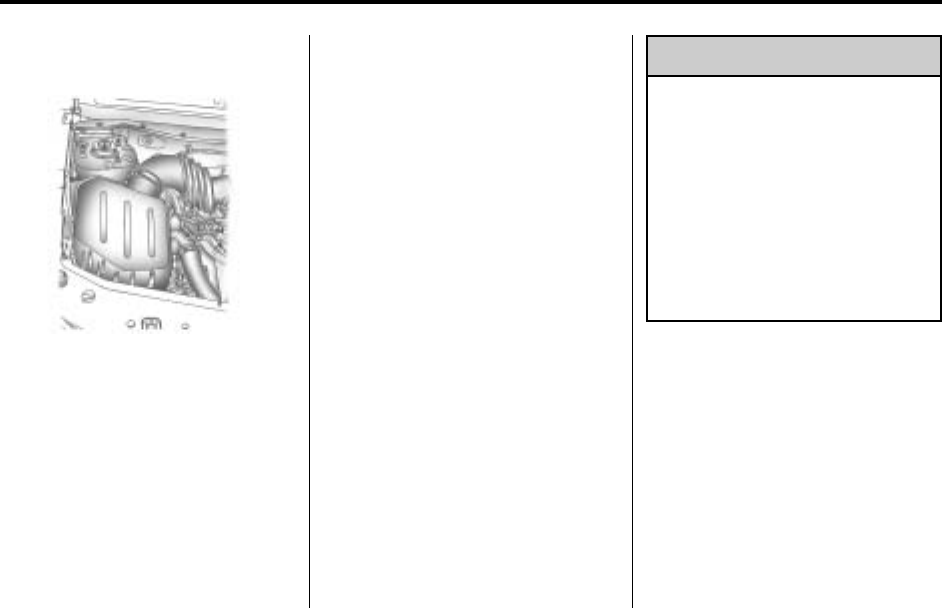Owner's Manual
Table Of Contents
- 2010 Saturn VUE BookTOC
- Introduction
- In Brief
- Keys, Doors and Windows
- Seats and Restraints
- Head Restraints
- Front Seats
- Rear Seats
- Safety Belts
- Airbag System
- Where Are the Airbags?
- When Should an Airbag Inflate?
- What Makes an Airbag Inflate?
- How Does an Airbag Restrain?
- What Will You See After an Airbag Inflates?
- Passenger Sensing System
- Servicing the Airbag-Equipped Vehicle
- Adding Equipment to the Airbag-Equipped Vehicle
- Airbag System Check
- Replacing Airbag System Parts After a Crash
- Child Restraints
- Storage
- Instruments and Controls
- Controls
- Warning Lights, Gages, and Indicators
- Instrument Cluster
- Speedometer
- Odometer
- Trip Odometer
- Tachometer
- Fuel Gage
- Safety Belt Reminders
- Airbag Readiness Light
- Passenger Airbag Status Indicator
- Charging System Light
- Malfunction Indicator Lamp
- Service Vehicle Soon Light
- Brake System Warning Light
- Antilock Brake System (ABS) Warning Light
- All-Wheel-Drive Light
- Power Steering Warning Light
- StabiliTrak® Indicator Light
- Traction Control System (TCS) Warning Light
- Engine Coolant Temperature Warning Light
- Tire Pressure Light
- Engine Oil Pressure Light
- Change Engine Oil Light
- Low Fuel Warning Light
- Security Light
- Reduced Engine Power Light
- High-Beam on Light
- Fog Lamp Light
- Low Washer Fluid Warning Light
- Cruise Control Light
- Door Ajar Light
- Gate Ajar Light
- Information Displays
- Vehicle Messages
- Battery Voltage and Charging Messages
- Brake System Messages
- Compass Messages
- Cruise Control Messages
- Door Ajar Messages
- Engine Cooling System Messages
- Engine Oil Messages
- Engine Power Messages
- Fuel System Messages
- Key and Lock Messages
- Ride Control System Messages
- Airbag System Messages
- Service Vehicle Messages
- Tire Messages
- Transmission Messages
- Vehicle Reminder Messages
- Vehicle Personalization
- Universal Remote System
- Lighting
- Infotainment System
- Climate Controls
- Driving and Operating
- Vehicle Care
- General Information
- Vehicle Checks
- Doing Your Own Service Work
- Hood
- Engine Compartment Overview
- Engine Oil
- Engine Oil Life System
- Automatic Transmission Fluid
- Engine Air Cleaner/Filter
- Cooling System
- Engine Coolant
- Engine Overheating
- Power Steering Fluid
- Washer Fluid
- Brakes
- Brake Fluid
- Battery
- All-Wheel Drive
- Starter Switch Check
- Automatic Transmission Shift Lock Control System Check
- Ignition Transmission Lock Check
- Park Brake and P (Park) Mechanism Check
- Wiper Blade Replacement
- Headlamp Aiming
- Bulb Replacement
- Electrical System
- Wheels and Tires
- Tires
- Tire Sidewall Labeling
- Tire Designations
- Tire Terminology and Definitions
- Tire Pressure
- Tire Pressure for High-Speed Operation
- Tire Pressure Monitor System
- Tire Pressure Monitor Operation
- Tire Inspection
- Tire Rotation
- When It Is Time for New Tires
- Buying New Tires
- Different Size Tires and Wheels
- Uniform Tire Quality Grading
- Wheel Alignment and Tire Balance
- Wheel Replacement
- Tire Chains
- If a Tire Goes Flat
- Tire Changing
- Compact Spare Tire
- Jump Starting
- Towing
- Appearance Care
- Service and Maintenance
- Technical Data
- Customer Information
- Customer Information
- Customer Satisfaction Procedure
- Customer Assistance Offices
- Customer Assistance for Text Telephone (TTY) Users
- Online Owner Center
- GM Mobility Reimbursement Program
- Roadside Assistance Program
- Scheduling Service Appointments
- Courtesy Transportation Program
- Collision Damage Repair
- Service Publications Ordering Information
- Reporting Safety Defects
- Vehicle Data Recording and Privacy
- Customer Information
- Index

Vehicle Care 10-13
To inspect or replace the engine air
cleaner/filter, do the following:
1. Remove the clamp on the air
duct hose.
2. Disconnect the hose.
3. Remove the four bolts on the
side of the air cleaner assembly.
4. Turn the cover upward to
disengage the cover hinges.
5. Remove the air cleaner cover
assembly and air filter element.
6. Inspect or replace the air filter
element.
If the air filter element is dirty,
you should replace it. If it is only
dusty, it may be cleaned by
blowing compressed air through
it from the clean side.
Make sure you are away from
the engine compartment when
cleaning the air filter with
compressed air.
Wipe all dust from inside of the
housing and inspect the air
cleaner and air outlet duct for
cracks, cuts and deterioration.
The air outlet duct must be
replaced if damaged.
7. Reverse Steps 1 through 5 to
reinstall the engine air cleaner/
filter cover and air duct hose.
{
WARNING
Operating the engine with the air
cleaner/filter off can cause you or
others to be burned. The air
cleaner not only cleans the air; it
helps to stop flames if the engine
backfires. If it is not there and the
engine backfires, you could be
burned. Do not drive with it off,
and be careful working on the
engine with the air cleaner/
filter off.
Notice: If the air cleaner/filter is
off, dirt can easily get into the
engine, which could damage it.
Always have the air cleaner/filter
in place when you are driving.










